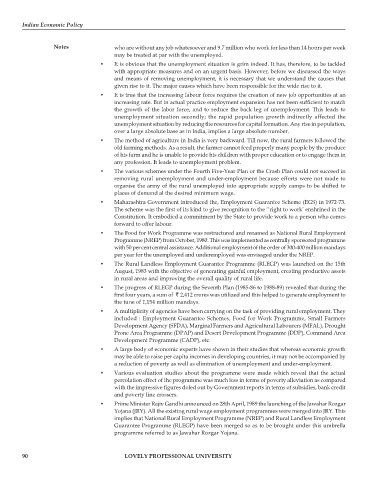Page 96 - DECO502_INDIAN_ECONOMIC_POLICY_ENGLISH
P. 96
Indian Economic Policy
Notes who are without any job whatesoever and 9.7 million who work for less than 14 hours per week
may be treated at par with the unemployed.
• It is obvious that the unemployment situation is grim indeed. It has, therefore, to be tackled
with appropriate measures and on an urgent basis. However, before we discussed the ways
and means of removing unemployment, it is necessary that we understand the causes that
given rise to it. The major causes which have been responsible for the wide rise to it.
• It is true that the increasing labour force requires the creation of new job opportunities at an
increasing rate. But in actual practice employment expansion has not been sufficient to match
the growth of the labor force, and to reduce the back leg of unemployment. This leads to
unemployment situation secondly; the rapid population growth indirectly affected the
unemployment situation by reducing the resources for capital formation. Any rise in population,
over a large absolute base as in India, implies a large absolute number.
• The method of agriculture in India is very backward. Till now, the rural farmers followed the
old farming methods. As a result, the farmer cannot feed properly many people by the produce
of his farm and he is unable to provide his children with proper education or to engage them in
any profession. It leads to unemployment problem.
• The various schemes under the Fourth Five-Year Plan or the Crash Plan could not succeed in
removing rural unemployment and under-employment because efforts were not made to
organise the army of the rural unemployed into appropriate supply camps to be shifted to
places of demand al the desired minimum wage.
• Maharashtra Government introduced the, Employment Guarantee Scheme (EGS) in 1972-73.
The scheme was the first of its kind to give recognition to the ‘’right to work’ enshrined in the
Constitution. It embodied a commitment by the State to provide work to a person who comes
forward to offer labour.
• The Food for Work Programme was restructured and renamed as National Rural Employment
Programme (NREP) from October, 1980. This was implemented as centrally sponsored programme
with 50 per cent central assistance. Additional employment of the order of 300-400 million mandays
per year for the unemployed and underemployed was envisaged under the NREP.
• The Rural Landless Employment Guarantee Programme (RLEGP) was launched on the 15th
August, 1983 with the objective of generating gainful employment, creating productive assets
in rural areas and improving the overall quality of rural life.
• The progress of RLEGP during the Seventh Plan (1985-86 to 1988-89) revealed that during the
first four years, a sum of ` 2,412 crores was utilized and this helped to generate employment to
the tune of 1,154 million mandays.
• A multiplicity of agencies have been carrying on the task of providing rural employment. They
included : Employment Guarantee Schemes, Food for Work Programme, Small Farmers
Development Agency (SFDA), Marginal Farmers and Agricultural Labourers (MFAL), Drought
Prone Area Programme (DPAP) and Desert Development Programme (DDP), Command Area
Development Programme (CADP), etc.
• A large body of economic experts have shown in their studies that whereas economic growth
may be able to raise per capita incomes in developing countries, it may not be accompanied by
a reduction of poverty as well as elimination of unemployment and under-employment.
• Various evaluation studies about the programme were made which reveal that the actual
percolation effect of the programme was much less in terms of poverty alleviation as compared
with the impressive figures doled out by Government reports in terms of subsidies, bank credit
and poverty line crossers.
• Prime Minister Rajiv Gandhi announced on 28th April, 1989 the launching of the Jawahar Rozgar
Yojana (JRY). All the existing rural wage employment programmes were merged into JRY. This
implies that National Rural Employment Programme (NREP) and Rural Landless Employment
Guarantee Programme (RLEGP) have been merged so as to be brought under this umbrella
programme referred to as Jawahar Rozgar Yojana.
90 LOVELY PROFESSIONAL UNIVERSITY

